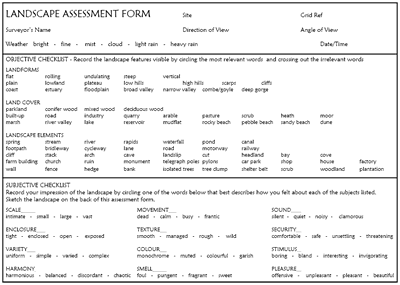landscape
assessment - part 1 - the language
 |
Agricultural river
valley at Restormel |
Cornish rivers flow through a
wide variety of landscapes - moorland, farmland, woodland, lowland,
coastal, industrial and urban landscapes. Many people have an image
of their local river flowing through a particular landscape because
it is a place where they usually see their local river. In fact,
if they went to the source of the same river they might find it
flowing through a completely different landscape. If they went to
the estuary the coastal landscape would be dramatically different,
yet perhaps only a few miles down stream.
The following exercises help you to explore the
different features that make up the landscapes of Cornwall.
There are many methods used to
make landscape assessments of countryside areas. The Landscape Assessment
form below will be used to record information about the location
(G1),
appearance and topography (G1)
of the site assessed.
• Look at the Landscape Assessment form,
do you know what all the words mean?

click on the picture of the
Landscape Assessment Form, to open an enlarged version
• This landscape assessment
is based on objective and subjective information. Find out the meanings
of these two words. When using the objective checklist everyone
in the class should come up with the same answers - when using the
subjective checklist there will be lots of different answers, which
show the different ways people feel about the landscape. There is
one right answer in an objective assessment - there are lots of
right answers in a subjective assessment.
• In class create a glossary
of your own to explain what all the words in the ‘Objective
Checklist’ section mean. There is a glossary page (G1)
on this CD, have a look at it, it will give you an idea of how to
go about putting together your own glossary.
• You may wish to discuss the meanings
of some of the words with your classmates and teacher. Use a dictionary
or thesaurus to help with the more complicated words.
• At home create a second
glossary, this time for the words in the ‘Subjective Checklist’.
Again you might need to use a dictionary or thesaurus to help. The
words you are explaining the meaning of in this glossary are subjective.
This means that when you assess whether something is, for example
comfortable or threatening, someone else may not agree with you,
it is how you feel about something.
|

